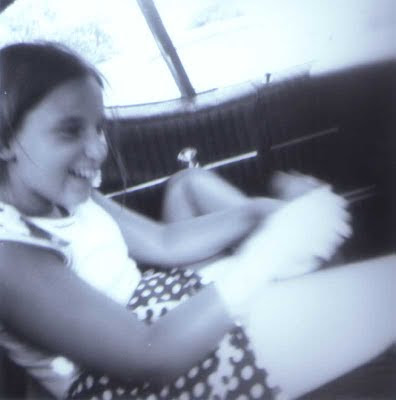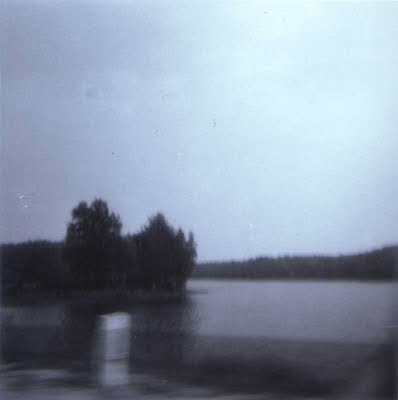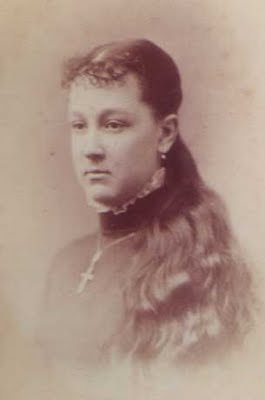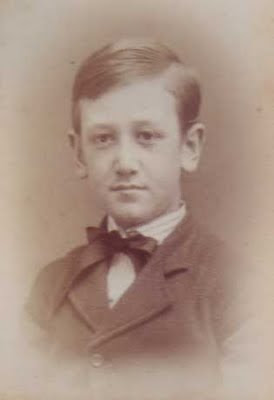Monday, November 30, 2009
Sunday, November 29, 2009
Saturday, November 28, 2009
Friday, November 27, 2009
Thursday, November 26, 2009
Plymouth Rock - Summer 1970
Here it is. Here's the rock. The Aldrich family did not arrive with the Pilgrims in 1620, but George Aldrich did arrive in 1631. I've been told the Native Americans took one look at Georgie Boy and thought, "There goes the neighborhood."
I'm on the left. My Godmother Jean and her daughter Donna are on the right.
My mother Doralice, Donna and me.
Drivng to Plymouth Rock - Summer 1970
This is my Godmother Jean's daughter Donna. I think she's 13 or 14 in this picture. We're on the way to visit Plymouth Rock and Plymouth Village in the summer of 1970. I'm 15 about to turn 16.
Wednesday, November 25, 2009
Tuesday, November 24, 2009
Monday, November 23, 2009
Sunday, November 22, 2009
Saturday, November 21, 2009
Friday, November 20, 2009
Thursday, November 19, 2009
Wednesday, November 18, 2009
Tuesday, November 17, 2009
Monday, November 16, 2009
Sexy Thang with Curls
Okay, I think she's kinda hot with those long black curls. Is she pouting or scowling? I can't tell.
Julia Roberts could play her in the movie.
Sunday, November 15, 2009
Pink Cheeks and Fox Stole
I like to call her CHARLENE. I don't know why. She could also be a TERESA.
A stole can also mean a fur or set of furs, (usually fox) worn as a stole with a suit or gown; the pelage of a single animal (head included) is generally used with street dress while for formal wear a finished length of fur using the skins of more than one animal is used; the word stole stands alone or is used in combination: fur stole, mink stole.
-- wiki
Saturday, November 14, 2009
Dapper Thesbians Carl and Theodore
The first recorded case of an actor performing took place in 534 BC (though the changes in calendar over the years make it hard to determine exactly) when the Greek performer Thespis stepped on to the stage at the Theatre Dionysus and became the first known person to speak words as a character in a play or story. Prior to Thespis' act, stories were only known to be told in song and dance and in third person narrative. In honour of Thespis, actors are commonly called Thespians. Theatrical legend to this day maintains that Thespis exists as a mischievous spirit, and disasters in the theatre are sometimes blamed on his ghostly intervention.
Actors were traditionally not people of high status, and in the Early Middle Ages travelling acting troupes were often viewed with distrust. In many parts of Europe, actors could not even receive a Christian burial, and traditional beliefs of the region and time period held that this left any actor forever condemned. However, this negative perception was largely reversed in the 19th and 20th centuries as acting has become an honoured and popular profession and art.
-- wiki
Friday, November 13, 2009
Butch and Benjamin Are Brothers
Butch on the left looks more pleased than his tense brother Benjamin to his right. You can certainly tell these two boys are related. They both have the same nose.
Thursday, November 12, 2009
Petey Wears a Fauntleroy Outfit
The Fauntleroy suit appeared in Europe as well, but nowhere was it as popular as America. The classic Fauntleroy suit was a velvet cut-away jacket and matching knee pants worn with a fancy blouse with a large lace or ruffled collar. These suits appear right after the publication of Mrs. Burnett's story (1885) and was a major fashion until after the turn of the 20th century. Many boys who did not wear an actual Fauntleroy suit, wore suits with Fauntleroy elements such as a fancy blouse or floppy bow. Only a minority of boys wore ringlet curls with these suits, but the photographic record confirms that many boys did. It was most popular for boys about 3–8 years of age, but some older boys wore them as well. It has been speculated that the popularity of the style encouraged many mothers to breech their boys earlier than before and was a factor in the decline of the fashion of dressing small boys in dresses and other skirted garments.
-- wiki
Wednesday, November 11, 2009
Uma Thurman's Great Great Grandmother
While Lucrezia here looks a lot like Uma's ancestor, she also looks like another one of those Nurse Jackie QUIET AND MEAN types. This one's a stern taskmaster. She probably chewed out the photographer for taking too long. Or if he's her husband, I wouldn't be surprised if she denied him sex regularly. This woman looks like a walking headache.
Tuesday, November 10, 2009
Fashionable Lady with Fur Collar and Feather Hat
Quite an outfit she's wearing. She could either be a Fifth Avenue old maid looking for love or a Bowery hooker in her Sunday best.
Her face begs to be named BESSIE.
Monday, November 9, 2009
Phoebe Fairchild
At first I couldn't tell if Phoebe here looks more WASP or Irish? I chose WASP and named her accordingly. I like her nose, but then I've always been a nose man.
Sunday, November 8, 2009
Plus Size Woman with Long Hair and Cross
Shirley here reminds me of an uneducated and terribly ignorant woman I knew back in my religious days. Besides being an aggressive gossip with a mouth as big as her belly, she once tried to intentionally get a rise out of me by arrogantly announcing that she had not yet decided if FILM was ART. I didn't take the bait. But I was this close to mocking her back, saying that she'd better hurry as the world was awaiting her decision.
Don't worry. There are no dart holes in this picture.
Saturday, November 7, 2009
Rich L_____'s Great Grandfather?
This looks a lot like a childhood photo of an actor/writer friend of mine who used to be obsessed with gambling and jogging.
Last time I saw him was on the Fox lot.
Friday, November 6, 2009
Minnie's Husband Georgie
This is Minnie's husband GEORGIE RICHTER. He also looks like a Walter, but "Walter Richter" doesn't sound right. Bet he enjoyed a lot of Minnie's kugel.
Thursday, November 5, 2009
Grandmother Richter Sure Looks Like A Minnie and Makes A Killer Kugel
Doesn't she look like her first name could be Minnie?
My wife and I are constantly assigning suitable names to people we see on the street. We usually agree with each other's choices. Good game to play while stuck in city traffic or waiting in line. I still think this woman could be Groucho Marx's mother MINNIE. I bet she made a killer kugel.
Kugel (Yiddish: קוגל kugl or קוגעל, pronounced either koogel or kigel, as was pronounced in Galicia) is any one of a wide variety of traditional baked Jewish side dishes consisting of ground or processed vegetables, fruit, or other starches combined with a thickening agent (such as oil, egg, or flour). It is sometimes translated as "pudding" or "casserole".
Kugels may be sweet or savory. The most common types are made from egg noodles (called lochshen kugels) or potatoes and often contain potatoes, but there are recipes in everyday use in modern Jewish kitchens for a great diversity of kugels made with different vegetables, fruit, batters, cheese, and other flavorings and toppings.
Some modern cooks add a small amount of baking powder. In addition to lightening the dish, the powder's alkaline chemistry breaks down the potatoes and produces a smoother texture while promoting browning.
Wednesday, November 4, 2009
Mean and Quiet like Nurse Jackie?
I can't tell if this woman looks more like Sarah Palin without glasses or a Nurse Jackie type?
"I don't like chatty. I don't do chatty. I like quiet.
Quiet and mean. Those are my people."
-- Nurse Jackie
Reminds of one of my college girlfriends. One of the mean ones. Although I don't remember her being too quiet, but she more than dabbled in the passive aggressive.
Tuesday, November 3, 2009
Pretty Woman with Earrings & Necklace
I have a passion for antique and vintage photography. So, I'm going to share pieces from my carte de visite, cabinet card, tintype, and daguerreotype collection during this month of November 2009. Enjoy.
The carte de visite or CDV (also carte-de-visite) was a type of small photograph which was patented in Paris, France by photographer André Adolphe Eugène Disdéri in 1854. It was usually made of an albumen print, which was a thin paper photograph mounted on a thicker paper card. The size of a carte de visite is 2⅛ × 3½ inches mounted on a card sized 2½ × 4 inches. It was made popular in 1859 in Europe, and from 1860 in the United States. The new invention was so popular it was known as "cardomania" and eventually spread throughout the world. In 1854, Disdéri had also patented a method of taking eight separate negatives on a single plate.
Each photograph was the size of a visiting card, and such photograph cards became enormously popular and were traded among friends and visitors. The immense popularity of these card photographs led to the publication and collection of photographs of prominent persons. "Cardomania" spread throughout Europe and then quickly to America. Albums for the collection and display of cards became a common fixture in Victorian parlors.
By the early 1870s, cartes de visite were supplanted by "cabinet cards," which were also usually albumen prints, but larger, mounted on cardboard backs measuring 4½ by 6½ inches. Cabinet cards remained popular into the early twentieth century, when Kodak introduced the Brownie camera and home snapshot photography became a mass phenomenon.
The Cabinet card was the style of photograph which was universally adopted for photographic portraiture in 1870. It consisted of a thin photograph that was generally mounted on cards measuring 4¼ by 6½ inches.
The Carte de visite process was quickly replaced by the larger Cabinet cards. In the early 1860s, both types of photographs were essentially the same in process and design. Both were most often albumen prints; the primary difference being the cabinet card was larger and usually included extensive logos and information on the reverse side of the card to advertise the photographer’s services. However, later into its popularity, other types of papers began to replace the albumen process. Despite the similarity, the cabinet card format was initially used for landscape views before it was adopted for portraiture.
Some cabinet card images from 1890s have the appearance of a black and white photograph in contrast to the distinctive sepia toning notable in the albumen print process. These photographs have a neutral image tone and were most likely produced on a matte collodion, gelatin or gelatin bromide paper.
Sometimes images from this period can be identified by a greenish cast. Gelatin papers were introduced in the 1870s and started gaining acceptance in the 1880s and 1890s as the gelatin bromide papers became popular. Matte collodion was used in the same period. A true black and white image on a cabinet card is likely to have been produced in the 1890s or after 1900. The last cabinet cards were produced in the twenties, even as late as 1924.
Owing to the larger image size, the cabinet card steadily increased in popularity during the second half of the 1860s and into the 1870s, replacing the carte de visite as the most popular form of portraiture. The cabinet card was large enough to be easily viewed from across the room when typically displayed on a cabinet, which is probably why they became known as such in the vernacular. However, when the renowned Civil War photographer, Mathew Brady, first started offering them to his clientèle towards the end of 1865, he used the term, "Imperial Carte-de-Visite." Whatever the name, the popular print format joined the photograph album as a fixture in the late 19th century Victorian parlor.
Ironically, early into its introduction, the cabinet card ushered in the temporary demise of the photographic album which had come into existence commercially with the carte de visite. Photographers began employing artists to retouch photographs (by altering the negative before making the print) to hide facial defects revealed by the new format. Small stands and photograph frames for the table top replaced the heavy photograph album. Photo album manufacturers responded by producing albums with pages primarily for cabinet cards with a few pages in the back reserved for the old family carte de visite prints.
For nearly three decades after the 1860s, the commercial portraiture industry was dominated by the carte de visite and cabinet card formats. In the decade before 1900 the number and variety of card photograph styles expanded in response to declining sales. Manufactures of standardized card stock and print materials hoped to stimulate sales and retain public interest in card photographs. However, as with all technological innovations, the public increasingly demanded outdoor and candid photographs with enlarged prints which they could frame or smaller unmounted snapshots they could collect in scrapbooks.
In no small part owing to the immense popularity of the affordable Kodak Box Brownie camera, first introduced in 1900, the public increasingly began taking their own photographs and thus the popularity of the cabinet card declined.
-- wiki






































